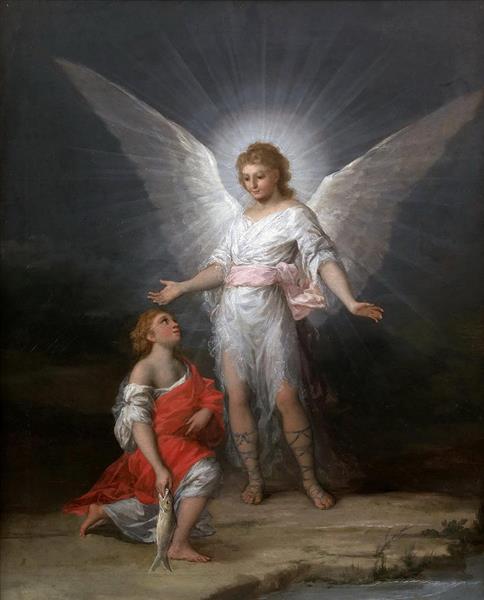Beschrijving
Francisco Goya's painting "Tobias and the Angel," painted between 1772 and 1775, is a work that encapsulates both the artist's technical mastery and a narrative rich in symbolism and meaning. In this work, Goya depicts the moment when young Tobias, accompanied by the archangel Raphael, embarks on a journey that is not only physical, but also spiritual, in search of the healing of his father, Tobit. The story, which comes from the Book of Tobit and is framed within Jewish tradition, becomes, for Goya, a reflection on faith, protection, and personal journey.
The composition of the work is notable for its balance and fluidity. Goya uses a diagonal arrangement that leads the viewer's gaze from the bottom left, where Tobias is, to the top right, where the angel appears. This movement guides the visual reading of the work and emphasizes the relationship between the two characters. Tobias appears in a contemplative pose, with an expression of innocence and wonder, while the angel appears imposing and serene, illuminated by a soft halo of light that contrasts with the dimness of the background. This selective lighting, characteristic of Goya, allows viewers to concentrate on the interaction between the characters, creating an atmosphere of transcendence in the midst of the everyday.
The use of colour in this painting is equally significant. Goya combines warm and cool tones, with ochres and blues predominating. The background features a natural landscape that is presented as a reflection of the emotional complexity of the journey. The vegetation and the sky, in a palette of greens and blues, merge into an environment that evokes both hope and uncertainty of the path that awaits them. This choice of colour not only sets the mood, but also indicates the emotional state of the characters; the luminosity of the angel contrasts with the opacity of the surroundings, symbolising his role as guide and protector.
The characters, Tobias and the angel Raphael, are actively engaged in a visual dialogue that implies trust and camaraderie. Raphael, depicted in white garb that symbolizes purity and the divine, also carries a fish, a crucial element of the story that alludes to protection and healing, as the fish will play a vital role in Tobit’s cure. Goya imbues his figures with a palpable humanity, making the viewer identify with their journey. The angel is not just a heavenly figure; he is an agent of change and salvation, which adds a deeply human dimension to the painting.
The work reflects Goya's stylistic evolution in his early years, where he still adheres to the traditions of Rococo, but already begins to hint at the romanticism that would define his later work. The treatment of light and shadow, as well as the attention to detail in the faces and clothing, mark a transition towards a more personal and emotional style that Goya would develop throughout his career.
Tobias and the Angel also stands as a testament to Goya's interest in moral narrative and the exploration of the supernatural within an everyday context. The work is not only a representation of a biblical tale, but becomes a meditation on the human condition, the search for faith, and the importance of guidance in times of uncertainty. Goya, through his exceptional technical skill and keen psychological insight, invites us to contemplate not only the story of Tobias, but also our own journeys and challenges on the path of life. Thus, this painting establishes itself as a key work not only in Goya's oeuvre, but in the development of European art, marking a bridge between different periods and styles.
KUADROS ©, a famous painting on your wall.
Hand-made oil painting reproductions, with the quality of professional artists and the distinctive seal of KUADROS ©.
Painting reproduction service with satisfaction guarantee. If you are not completely satisfied with the replica of your painting, we will refund 100% of your money.

